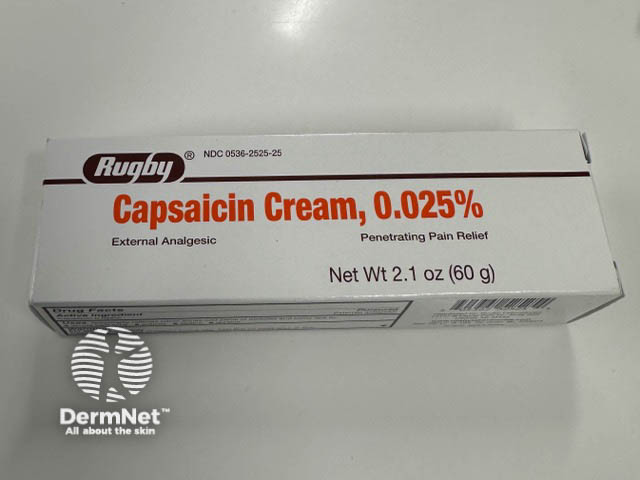Main menu
Common skin conditions

NEWS
Join DermNet PRO
Read more
Quick links
Capsaicin — extra information
Capsaicin
Last reviewed: December 2023
Author(s): Dr Libby Whittaker, DermNet Medical Writer (2023)
Previous contributors: Vanessa Ngan, Staff Writer (2002)
Reviewing dermatologist: Dr Ian Coulson
Edited by the DermNet content department
Introduction
How it works
Uses
How to use
Precautions
Side effects
What is capsaicin?
Capsaicin is a topical analgesic used for symptom relief in osteoarthritis and some neuralgic conditions such as post-herpetic neuralgia.
It is available as a topical cream or patch, depending on location.

A chilli, the source of capsaicin

0.025% capsaicin cream
What is capsaicin used for?
Capsaicin is approved for relief of pain associated with osteoarthritis.
It has also been used for symptom relief for a variety of conditions that cause localised neuropathic pain. Uses include the following (some of which is off-label):
- Post-herpetic neuralgia following shingles (herpes zoster)
- Trigeminal neuralgia: episodes of intense, stabbing, electric shock-like facial pain where the trigeminal nerve endings reach (lips, eyes, nose, scalp, forehead, and jaw)
- Atypical facial pain: often described as burning, aching, or cramping that occurs on one side of the face, and can extend into the upper neck or back of the scalp
- Brachioradial pruritus
- Notalgia paraesthetica
- Nodular prurigo (prurigo nodularis)
- Lichen simplex chronicus
- Lichen amyloidosis (see: (cutaneous amyloidosis)(/topics/cutaneous-amyloidosis)
- Painful diabetic neuropathy
- Cutaneous dysaesthesia
- Apocrine chromhidrosis
- Drug-induced pruritus
- Localised uraemic pruritus in palliative care
- Burning mouth syndrome.
How does capsaicin work?
Capsaicin is the purified extracted alkaloid from red chilli peppers (capsicums). This is the substance that makes chilli peppers hot.
Capsaicin is thought to bind to nociceptors in the skin where it is applied, causing proinflammatory neuropeptides (eg, substance P) to be released. This leads to initial enhanced sensitivity, often felt as burning or itching, but over time depletion of substance P and nociceptor desensitisation is proposed to lead to a reduction in pain.
Capsaicin application
Capsaicin cream
- Concentration is usually 0.025–0.075%; 0.1% is considered high potency.
- Apply a small amount of cream and rub it well into the affected area 3–4 times daily.
- Wash hands after application; wait at least 30 minutes before doing so if using for arthritis affecting the hands.
- For post-herpetic neuralgia, only apply capsaicin after shingles sores have healed.
- Capsaicin should be used daily as directed. Immediate pain relief is not typical. Maximal symptom relief may take several weeks of regular use to achieve.
Capsaicin patch
- Low concentration (eg, 0.025%) patches may be available over-the counter.
- High concentration (8%) patches are prescription only.
- These need to be applied by trained providers in healthcare clinics. Pretreatment local anaesthetic and oral analgesia can be used to reduce side effects.
- Total dose and time of application varies depending on concentration and indication.
- For example, a suggested regime for an 8% patch for postherpetic neuralgia (with each patch containing 179 mg of capsaicin) is up to 4 patches applied to the area for 60 minutes; reapplied if required after a minimum of 3 months.
What are the precautions and contraindications with capsaicin?
Precautions
- Test first on a small area of skin.
- Don’t apply capsaicin to broken or infected skin.
- Avoid use near eyes or other sensitive areas of the body.
- If capsaicin gets into the eyes, flush them with water.
- Wash other sensitive areas with warm soapy water.
- Tight bandages should not be applied on top of capsaicin cream.
- Avoid using other topical analgesics or heat packs on the area at the same time.
Contraindications
- Allergy to capsicum or chilli peppers.
What are the benefits of capsaicin?
Capsaicin has been found to provide some degree of relief in various neuropathic pain conditions.
A Cochrane review found that ≥6 weeks of treatment with 0.075% capsaicin cream was associated with:
- Greater clinical success for capsaicin (41%) than placebo (26%); risk ratio 1.59 (p = 0.001)
- Number needed to treat (to benefit 1 patient over placebo): 6.6.
High concentration capsaicin patches (8%) have been associated with more patients experiencing moderate or substantial pain relief in post-herpetic neuralgia: number needed to treat (to benefit 1 patient over low concentration capsaicin) approx. 7–9 (at 8–12 weeks). Requiring a single patch application per 3 months rather than regular use of cream can also help with non-adherence.
What are the disadvantages of capsaicin?
- Depending on the type of pain, the full effect may take several weeks to achieve.
- Capsaicin cream needs to be applied regularly.
- High dose patches need to be applied much less often but have to be administered at specialist clinics and can cause more intense side effects initially.
- At the time of writing, in some regions there are supply issues with capsaicin.
What are the side effects and risks of capsaicin?
The most common side effect of capsaicin use (approx. 50%) is a mild to moderate stinging or burning sensation after application. This sensation is related to the action of capsaicin on the skin and is to be expected. It usually diminishes after the first few days of application and in most cases will disappear with time and continued use.
Cases of irritant or allergic contact dermatitis have been reported, and rare cases of burns.
Approved datasheets are the official source of information for medicines, including approved uses, doses, and safety information. Check the individual datasheet in your country for information about medicines.
We suggest you refer to your national drug approval agency such as the Australian Therapeutic Goods Administration (TGA), US Food and Drug Administration (FDA), UK Medicines and Healthcare products regulatory agency (MHRA) / emc, and NZ Medsafe, or a national or state-approved formulary eg, the New Zealand Formulary (NZF) and New Zealand Formulary for Children (NZFC) and the British National Formulary (BNF) and British National Formulary for Children (BNFC).
Bibliography
- Anand P, Bley K. Topical capsaicin for pain management: therapeutic potential and mechanisms of action of the new high-concentration capsaicin 8% patch. Br J Anaesth. 2011 Oct;107(4):490–502. doi: 10.1093/bja/aer260. Journal
- Barker C, Elston DM. Botanical Briefs: Handling the Heat From Capsicum Peppers. Cutis. 2023 May;111(5):241–243. doi: 10.12788/cutis.0761. Journal
- Derry S, Lloyd R, Moore RA, et al. Topical capsaicin for chronic neuropathic pain in adults. Cochrane Database Syst Rev. 2009 Oct 7;(4):CD007393. doi: 10.1002/14651858.CD007393.pub2. Journal
- Derry S, Rice ASC, Cole P, et al. Topical capsaicin (high concentration) for chronic neuropathic pain in adults. Cochrane Database Syst Rev. 2017;1(1):CD007393. doi: 10.1002/14651858.CD007393.pub4. Journal
- Food and Drug Administration. FDA Drug Safety Communication: Rare cases of serious burns with the use of over-the-counter topical muscle and joint pain relievers. September 13, 2012. Accessed July 27, 2023. Available from: https://medsafe.govt.nz/profs/PUArticles/Dec2012PainRelief.htm
- Laklouk M, Baranidharan G. Profile of the capsaicin 8% patch for the management of neuropathic pain associated with postherpetic neuralgia: safety, efficacy, and patient acceptability. Patient Prefer Adherence. 2016;10:1913–1918. doi: 10.2147/PPA.S76506. Journal
On DermNet
Other websites
- Capsaicin transdermal patch — MedlinePlus
- Qutenza® (capsaicin) patch prescribing information
- Capsaicin topical — MedlinePlus
- Zostrix-HP (capsaicin 0.075%) cream prescribing information
